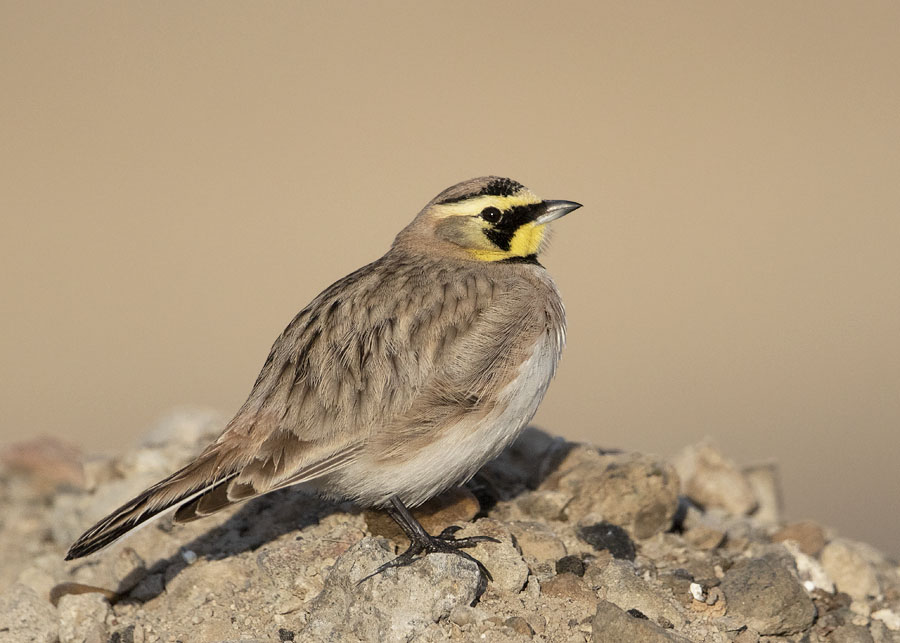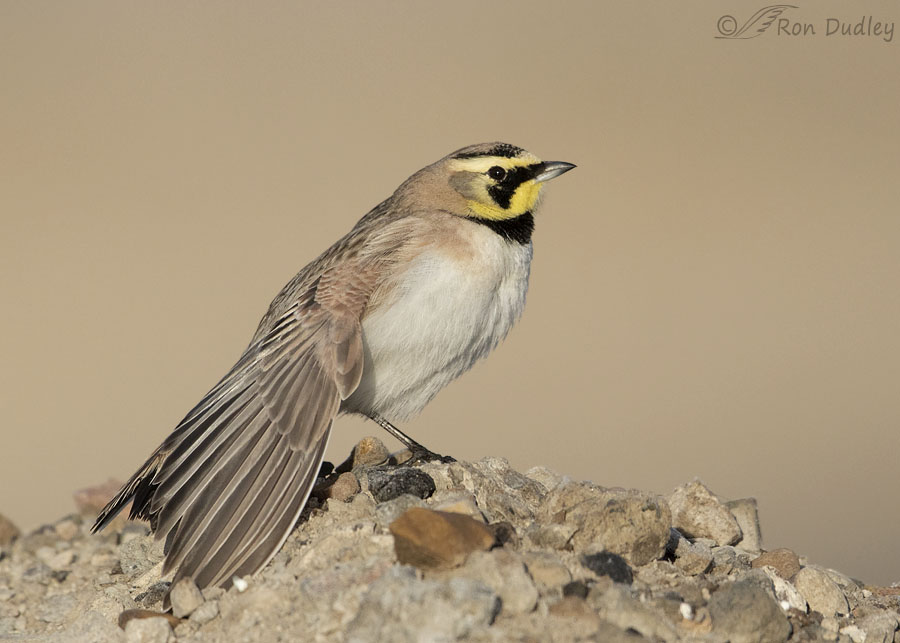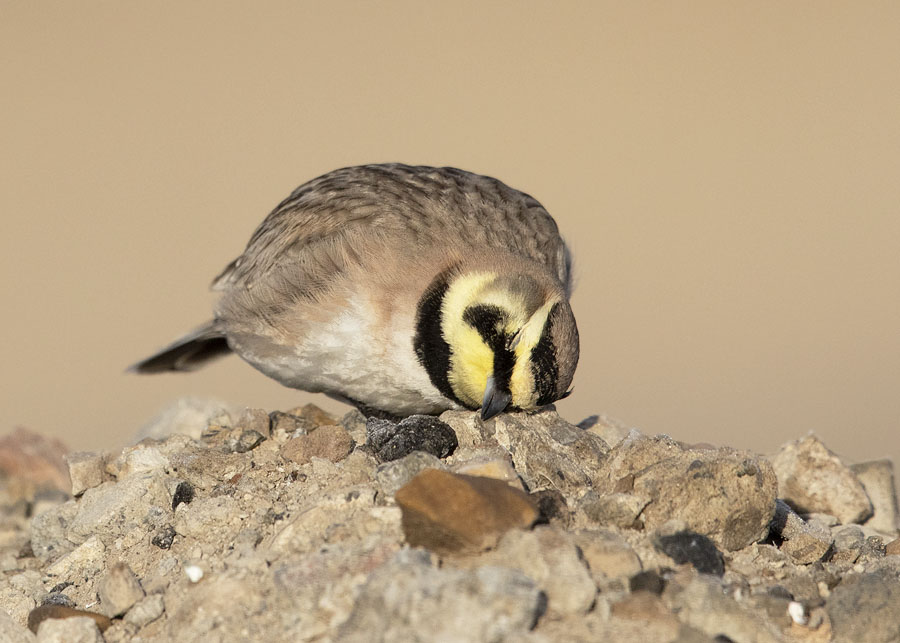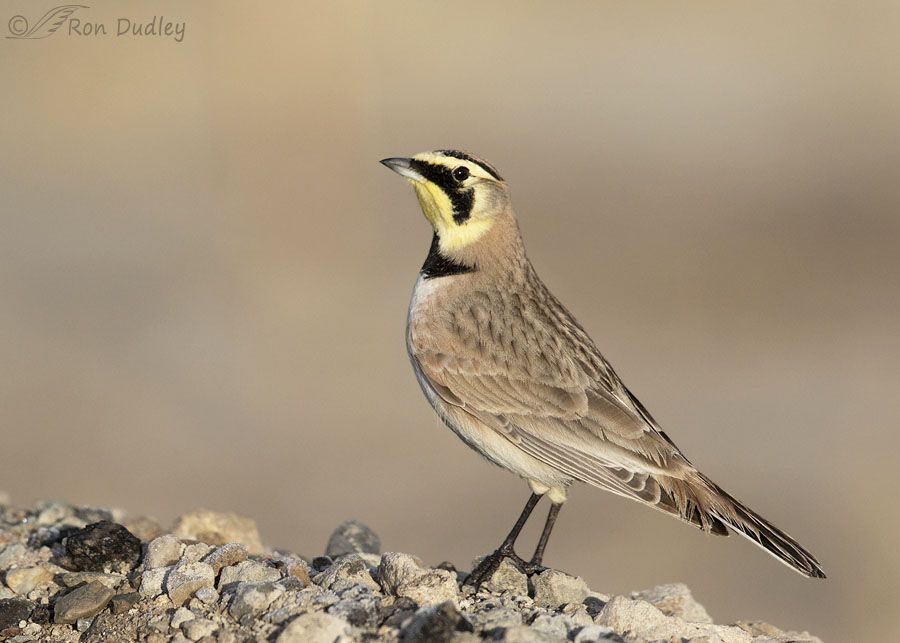Another in my irregular series on the ‘common’ species.

1/8000, f5.6, ISO 800, Canon 7D Mark II, Canon EF 500mm f/4L IS II USM + EF 1.4 III Extender, not baited, set up or called in
Horned Larks are both common and widespread but that doesn’t mean they’re always easy to find or get close to. I especially like to photograph them beginning this time of year when their colors start to brighten up so I was happy to find this cooperative male yesterday morning.

1/5000, f6.3, ISO 800, Canon 7D Mark II, Canon EF 500mm f/4L IS II USM + EF 1.4 III Extender, not baited, set up or called in
He ascended to the top of the rocks and performed a nice wing stretch in good light with a clean background.

1/4000, f6.3, ISO 800, Canon 7D Mark II, Canon EF 500mm f/4L IS II USM + EF 1.4 III Extender, not baited, set up or called in
I thought he was pretty cute while he was cleaning his beak on the rocks, even though he had his eyes closed.

1/4000, f6.3, ISO 800, Canon 7D Mark II, Canon EF 500mm f/4L IS II USM + EF 1.4 III Extender, not baited, set up or called in
He gave me an alert pose before he partially disappeared over the far side of the rocks. I never did get any photos I like very much of him singing or with his ‘horns’ erected.
Horned Larks are another species often ignored by photographers because of their abundance in many areas and because from a distance their soft colors can be hard to see so they resemble just another ‘little brown job’. But I think they’re lovely little birds with subtle colors and a soft, appealing call.
Besides, for me they bring back fond memories of growing up on the Montana farm where they were the most abundant birds of all.
Ron


Oh, the horned lark! How lovely. When i used to visit my folks at their place a couple of hours north of Cheyenne i always enjoyed sitting outside and listening to the birds… sometimes the horned larks, sometimes the meadowlarks, and sometimes the lark buntings. Those days have gone by, unfortunately. But thank you, Ron, for reminding me.
You really displayed the beauty in that little bird! It makes me miss our second home in Illinois, which we sold almost three years ago. We don/t see them here in south Florida.
I love the photo of him rubbing against the rock- ESP. with the eyes closed. Makes him look like he is really enjoying it.
Good point, Marcia.
Great photos! Some of favorite colors here the soft brown/yellow/black is stunning. Just love the beak cleaning photo! I’ve been seeing small flocks 5/7 of them along the roadsides and near field edges. With snow they are easier to spot but once that is gone they blend in with the clods/vegetation so well. I’ve not heard much in the way of their vocals yet though…that song is a good give away to look for them.
Kathy, as you’re apparently aware their call/song is a soft one that can be easy to miss but I love hearing it.
I love the beak cleaning pose! I have a question about color. I have been seeing many horned larks at BRMBR, Promontory and Salt Creek. None are as yellow as the ones on Antelope Island. Have you made this observation?
April, I see quite a bit of variation in color intensity in these birds, even in the springtime. I haven’t noticed it to be location specific but just because I haven’t noticed it doesn’t mean it doesn’t exist. .
Delight! Delight! Delight! Thank you for giving these more abundant birds their due. He is one dapper little fellow! I couldn’t make out his beak from the rocks in the original, so I “embiggened” the image and I’m so glad I did! His little tufts are so cute and he seems to really be enjoying himself. I imagine that a clean beak feels as good to him as having my teeth done at the dentist does to me. Just call me Captain Anthropomorphic today. 😂
Marty, you had to remind me of the dentist. I haven’t been in for a checkup for much too long, in large part because of Covid.. I hope I don’t pay the price before I visit him again.
Sorry about that. As much as I hate to quote Nike — “Just do it.” We went into the stay-at-home order the week before my dental appointment in March and I had to wait until summer, but it wasn’t so bad. I had finally found it in me to floss and hubby bought me a sonic toothbrush, so both of those helped. It’s never too late. 🙂
Beautiful as always.
Thanks, Janice.
BotW says “ variability within the species permits almost infinite subdivisions based on size and coloration.”’
I think you got the handsomest one.
Or one of the handsomest ones. He looks pretty snazzy doesn’t he, Lyle.
I zoomed in on the lark scratching on the rock—what a beautiful face, eye looks like it has lashes and “mouth” is curved in a smile. I’m very attentive to yellow birds with strongly marked heads/faces (e.g., Townsend’s warblers, Bullock’s
orioles) so this one would not escape my notice if I’d ever spotted one. Regrettably, not yet, but the year is young! Thanks for reminding us with these lovely photos.
Chris, when folks zoom in like that I wish they could see the detail I can see on the original high-resolution images. What a difference!
Something about yellow on a bird ❤️
I guess we have salmonella outbreak with our migrating Pine Siskins… it’s highly suggested to remove feeders and bird baths until spring😢 So today I’m taking them down and thoroughly clean up.
That’s too bad about your outbreak and your siskins, Diana. The biggest problem we have around here with disease spread at feeders is usually avian pox.
Wonderful series Ron! Thanks for sharing.
Charlotte Norton
Thanks, Charlotte.
A beauty. As the little brown jobs so often are (even without that splash of sunshine yellow) when we take the time to look.
Agreed, EC. Many of us, including me, should take the time to look more often.
Handsome guy! Very good shots, Ron. I have seen one only once, in the spring in Eastern Oregon at Malheur Wildlife Refuge. Very striking bird, once you get a good look.
“once you get a good look”
That’s the key isn’t it, Kathryn. Thank you.
What a lovely bird! Sadly, I don’t think I’ve ever seen one in person, despite that I’ve lived within their range. It’s possible that I have and just didn’t know it, or like you said, misidentified it. Then there’s the issue that I’m usually more focused on what the hawk and/or dog are doing. So thank you!
Laura, you might be in the same boat as so many others. May have seen them many times but just didn’t realize it.
I love seeing species that are common in one area but not in another. I have never seen one myself. The background certainly matches the colours!
Yup, “common” depends, doesn’t it Bruce. They’re really lovely little birds that many folks pay little or no attention to.
Agree that they are “around” here is N Central MT tho really don’t “notice” them for the most part unless “looking” and actually “seeing”…….😌 The 2nd photo with it cleaning it’s beak appeals to me…😄
Judy, when I was a kid on the farm they seemed to be everywhere but I just thought they were “sparrows” and didn’t distinguish them from other species. It took me a long time to actually notice the yellow they had and know they were something kind of special.
Excellent series Ron. My favorite is the wing spread. We show them here as fairly common in winter and uncommon in summer. They must frequent different habitats here than where I usually am because I rarely ever see one. I promise that if I see one I definitely will not ignore it.
Thanks, Everett. We have them here in varying numbers year-round. Horned Larks are a permanent resident throughout most of their breeding range – only the northernmost individuals migrate.